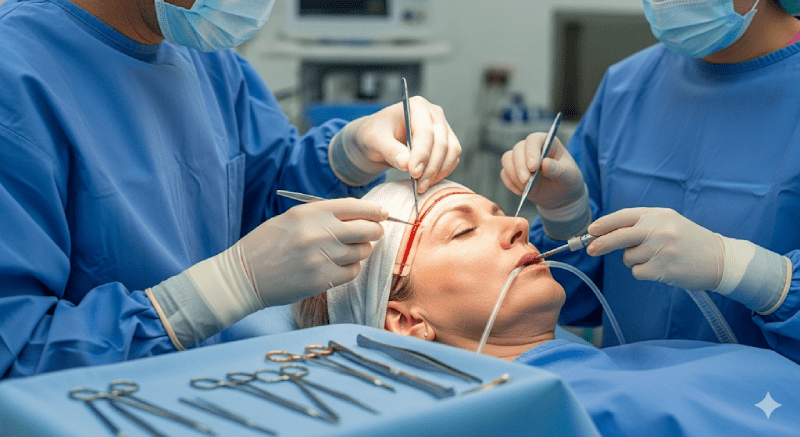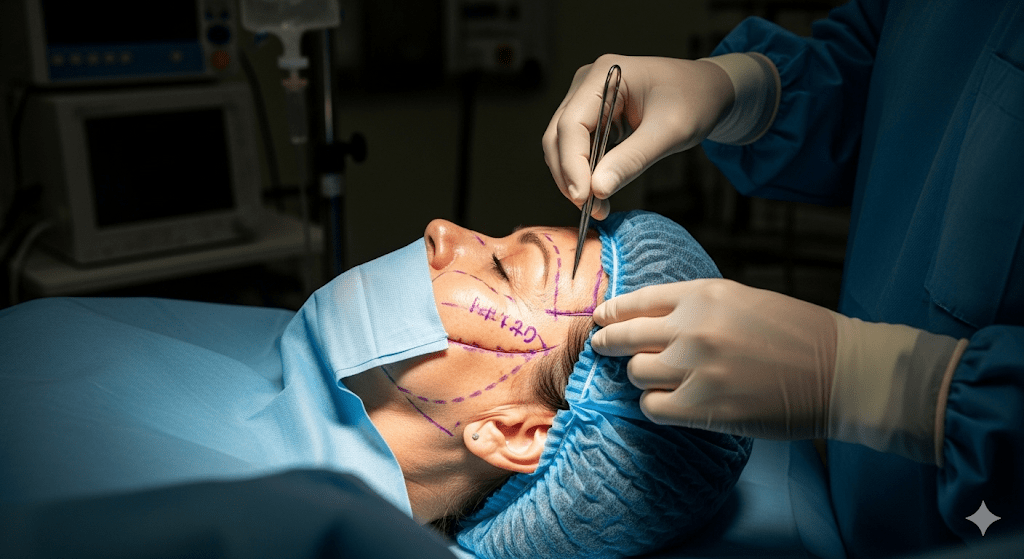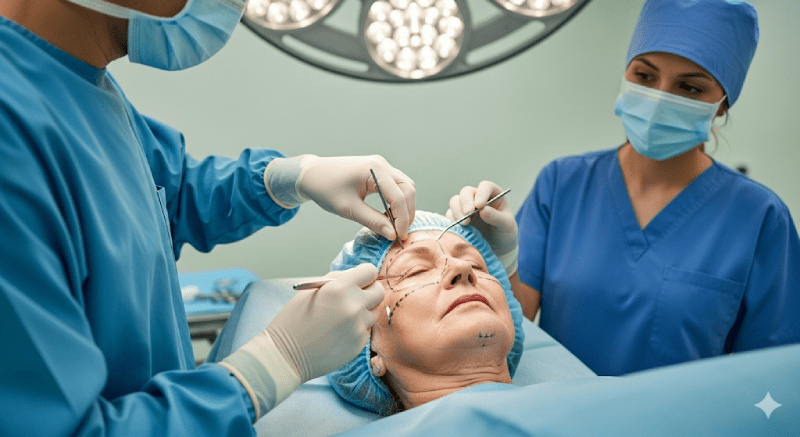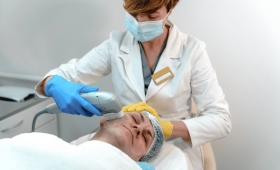What is a Facelift (Facial Aesthetics)?
A facelift, medically known as a rhytidectomy, is a surgical procedure performed to eliminate the signs of aging. With this procedure, sagging skin, wrinkles, and lines on the face and neck are removed. Facial muscles are tightened, and excess skin is removed to achieve a younger, smoother, and more dynamic appearance. This operation typically focuses on the jawline, neck, and cheek areas where the signs of aging are most prominent.
Who is it Suitable For?
A facelift operation is generally ideal for individuals between the ages of 40 and 70. However, as the signs of aging vary from person to person, this range can be wider. The most important criteria for candidates are as follows:
- Prominent Signs of Aging: Individuals with noticeable sagging and deep wrinkles on their face, neck, and jawline.
- Good General Health: Individuals who do not have serious health problems and are suitable for a surgical procedure.
- Realistic Expectations: Those who have realistic expectations about the results of the operation. A facelift does not turn back time; however, it slows down the aging process and provides a younger appearance.
- Flexible Skin Structure: The results are more successful in individuals with good skin elasticity.
Types Of Facelift Surgery In Turkey
Facelift surgeries are frequently performed aesthetic operations in Turkey to eliminate the signs of aging and give the face a younger appearance. These operations can be performed in different ways, depending on the degree of sagging on the face and the patient’s needs.
Full Facelift (Rhytidectomy): This is the most comprehensive facelift surgery. It is generally suitable for people aged 50 and over who have significant sagging on their face and neck. In this operation, incisions are made starting from the front of the ear and extending along the hairline. The excess skin on the face is removed and the underlying muscles and tissues (SMAS layer) are pulled up and tightened. This makes the jawline more prominent and tightens the neck area.
Mid-Facelift: This aims to solve problems such as deep lines on the cheeks and beside the nose (nasolabial folds) and under-eye bags. This surgery is performed with small incisions made under the eyelids or inside the hairline. The fat tissue and muscles in the cheek and mid-face area are lifted, creating a fuller and younger look.
Mini-Facelift: This is ideal for people with mild to moderate sagging, usually in their 40s. Shorter incisions are made compared to a full facelift (usually in front of the earlobe). This operation is used to correct slight sagging, especially in the jawline and neck area. The recovery process is faster and the scars are less noticeable.
Neck Lift: This is an operation performed to eliminate sagging in the neck area, jowl formation, and horizontal neck lines. It can be performed alone or together with a facelift. With incisions made under the chin or behind the ear, excess skin is removed and the neck muscles are tightened.
What Is SMAS (Superficial Musculoaponeurotic System) Facelift?
SMAS (Superficial Musculoaponeurotic System) facelift is a facelift surgery technique performed by intervening in the SMAS layer, which is one of the soft tissue layers of the face. This layer is a connective tissue system located on the facial and neck muscles and is the main cause of sagging due to aging.
The main purpose of this technique is to achieve more permanent and natural results by lifting the underlying SMAS layer instead of just tightening the skin. During the surgery, the SMAS membrane is usually accessed through incisions in the folds of the ear and is lifted and fixed. This way, sagging in the lower face, neck, and mid-face areas is eliminated, resulting in a more youthful appearance.
Who is good candidate for a SMAS facelift?
- Are over the age of 50
- Want to surgically correct one or more signs of aging on your face
- Still have some elasticity in your skin
- Are a non-smoker (this helps to be able to heal correctly after surgery)
- Are in good overall health

Risks and Complications of a Facelift
A facelift (rhytidectomy) operation is a significant surgical procedure performed to reduce the signs of aging in the face and neck area. As with any surgical procedure, a facelift operation has specific risks and potential complications. Understanding these risks allows you to make an informed decision before proceeding with the operation.
Common Potential Risks
These complications are generally mild and resolve on their own or with minimal intervention over time.
- Bruising and Swelling: This is one of the most common conditions after surgery. It usually subsides within a few weeks.
- Pain and Discomfort: Mild to moderate pain may be felt after surgery. This condition can be controlled with pain relievers prescribed by the doctor.
- Numbness or Sensation Changes: Temporary numbness, tingling, or loss of sensation may occur in the face and neck area. This is usually caused by a temporary effect on the nerves and returns to normal within months.
- Scars: In a facelift operation, incisions are made in front of the ear, behind the ear, and within the hairline. Although the surgeon tries to hide these scars as much as possible, they never disappear completely. They usually fade and become less noticeable over time.
Rarer but Serious Complications
These complications are less common but may require more serious intervention.
- Hematoma (Blood Clot): This is the accumulation of blood in the surgical area. It can cause a sudden increase in swelling and bruising. This condition should generally be evacuated with emergency surgical intervention.
- Infection: Although a rare risk, infection can develop in the surgical area. Symptoms may include redness, swelling, pain, and fever. Antibiotic treatment may be necessary.
- Nerve Damage: Damage to facial nerves can lead to muscle weakness or, in rare cases, permanent facial paralysis. This condition is usually temporary, but can be permanent in some cases.
- Asymmetry: Slight asymmetry may occur between the two sides of the face after surgery. This condition may not be completely corrected in some cases.
- Skin Necrosis (Tissue Loss): Death of skin tissue may occur as a result of impaired blood flow to the surgical area. This risk is higher in patients who smoke.
- Hair Loss: Temporary or permanent hair loss (alopecia) may occur on the scalp where the incisions were made.
- Anesthesia Complications: Since the facelift operation is performed under anesthesia, there are allergic reactions or other systemic risks associated with anesthesia.
How long does a facelift operation take?
The duration of the operation varies depending on the scope of the procedure. It generally takes between 2 to 5 hours.
What is the recovery process like?
The recovery process varies from person to person. Swelling and bruising are usually seen during the first few days. These symptoms largely disappear within a few weeks. You can return to your daily life 10-14 days after the surgery, but full recovery may take a few months.
Is a facelift permanent?
The results of a facelift operation are long-lasting for many years. However, as the aging process continues, new wrinkles and sagging may appear over time. The permanence of the results depends on the person’s lifestyle, genetic makeup, and skin care habits.
Will there be scars?
Surgeons make incisions in less visible areas, such as the hairline, behind the ears, and under the chin, to hide scars as much as possible. Scars that are initially prominent fade over time, becoming almost invisible.
Will there be pain after the surgery?
Mild to moderate pain or discomfort is normal after the surgery. This can be easily controlled with the painkillers prescribed by your doctor.
How Long-Lasting Is the Result of Facelift?
A facelift is a restorative procedure that “turns back the clock” on your appearance, but it doesn’t stop the natural aging process. The results are long-lasting, but not permanent, and they can vary significantly from person to person.
On average, a traditional or full facelift can last 10 to 15 years, while less invasive procedures like a mini facelift may last 5 to 10 years. The duration of the results is influenced by a number of key factors.
The Face Lift Operation Process
Face lift operations generally consist of the following stages:
Recovery: Swelling and bruising may occur after the operation, but these conditions diminish within a few weeks, giving way to a smoother and younger appearance.
Initial Consultation: Expert surgeons evaluate the patient’s facial structure and expectations to determine the most suitable treatment plan.
Operation: The operation is usually performed under general anesthesia. Surgeons rearrange the tissues under the skin and remove excess skin to provide a tighter appearance.
Factors Influencing Longevity
1. Type of Facelift and Surgical Technique
The technique used by the surgeon is a primary determinant of how long the results will last. Procedures that address the deeper tissues and muscles of the face, such as a deep plane or SMAS facelift, tend to yield longer-lasting and more durable results than those that only tighten the skin.
2. Your Skin and Genetics
- Skin Elasticity: Patients with good skin elasticity at the time of surgery generally have longer-lasting results. Elastic skin is more capable of conforming to the new, more youthful contours created by the surgery.
- Genetics: Your genetic predisposition to aging is also a factor. If your family members tend to age gracefully, your facelift results may last longer.
3. Age at the Time of Surgery
Generally, patients who undergo a facelift at a younger age (e.g., in their 40s or 50s) may see more enduring results because their skin and tissues are more resilient and have better quality.
4. Lifestyle and Aftercare
The most significant factors you can control to prolong your results are your daily habits after the surgery.
- Sun Protection: Sun exposure is a leading cause of premature aging. Consistent use of sunscreen (SPF 30+) and wearing protective clothing or hats is crucial.
- Smoking: Smoking severely impacts blood flow and damages the skin, which can significantly shorten the lifespan of your results.
- Weight Maintenance: Major weight fluctuations can cause the skin to stretch and sag, affecting the outcome of your facelift.
- Skincare: Following a consistent, high-quality skincare routine with products that contain antioxidants and retinoids can help maintain skin health and firmness.
What Happens When Results Fade?
Over time, you will continue to age from your new, more youthful baseline. You may notice a gradual reappearance of sagging skin or lines. Many people choose to have a “touch-up” procedure or a second facelift about a decade after the first to maintain their rejuvenated appearance.
Can other procedures be performed along with a facelift?
Yes, complementary procedures such as eyelid aesthetics (blepharoplasty), neck lift, or fat injection can often be performed along with a facelift. These procedures provide a more holistic and aesthetic result.
What are Facelift Surgery Process in Turkey
Initial Consultation
The first step of the process is a consultation with a plastic surgeon. During this meeting, the surgeon will thoroughly evaluate your expectations and health history. Your facial structure and the condition of your skin will be examined, and a decision will be made on whether the surgery is suitable for you. At this stage, the surgeon will explain the potential risks, the recovery process, and the possible results of the surgery. You should feel free to ask any questions you have.
Pre-operative Preparation
If the decision is made to proceed with the surgery, the surgeon will provide you with information about what you need to do before the operation. This usually includes stopping blood-thinning medications, smoking, and alcohol consumption for a period of time. Blood tests and certain health checks are typically requested before the surgery. Your surgeon will tell you in detail what to do the night before and the morning of the operation.
Day of Surgery
The surgery is usually performed under general anesthesia. The surgeon will remove excess skin, reshape the underlying tissues, and tighten the skin to achieve a more youthful appearance. The incisions are usually placed in hidden areas like the hairline, in front of the ear, and behind the ear. The duration of the surgery varies depending on the procedure but generally takes a few hours. After the surgery, your face will be bandaged to reduce swelling.
Recovery Process
It is normal to experience swelling, bruising, and mild pain in the first few days after the surgery. Your surgeon may prescribe pain relievers and antibiotics to manage this. Keeping your head elevated for the first few days helps to reduce swelling. The bandages are usually removed and stitches are taken out within about a week.
The full recovery process varies from person to person, but the bruising and swelling will largely decrease within a few weeks. It usually takes several months to see the final result of the surgery. Your surgeon will follow your recovery with regular check-ups during this process.

Precautions To Follow Before Having A Facelift In Turkey
1. Choose the Right Specialist and Clinic
The success of your surgery depends on the surgeon you choose. Therefore, it is essential to find an experienced plastic surgeon who is board-certified by an official organization like the Turkish Society of Plastic, Reconstructive, and Aesthetic Surgeons (TSPRAS) and specializes in this field. Also, be sure to research the reputation of the clinic where the surgery will be performed and ensure it has all the necessary equipment to handle potential complications. Being in a reliable environment with expert hands will be your greatest guarantee.
2. Quit Smoking
Smoking is one of the biggest enemies of the recovery process. It negatively affects circulation, preventing tissues from getting oxygen. This can delay wound healing and increase the risk of infection. You should completely stop smoking at least two weeks before the surgery and avoid smoking for at least two weeks after the operation.
3. Avoid Blood Thinners
Painkillers like aspirin and ibuprofen or blood thinners like warfarin can increase the risk of bleeding during and after surgery. Unless your surgeon advises otherwise, you must stop taking these medications at least two weeks before the surgery. Be sure to inform your doctor about all the medications you use.
4. Plan Your Recovery Period
A facelift requires a certain amount of time to heal. Therefore, it would be very wise to arrange for someone to help you with your daily activities after the operation. Using this resting period effectively is essential for a fast and comfortable recovery.
5. Follow Your Surgeon’s Instructions to the Letter
Your doctor will give you specific instructions for the period leading up to the surgery. These include what to eat and drink and which medications to avoid. Following these instructions meticulously is vital for a safe and successful operation. Remember, these rules are set for your health.
6. Set Realistic Expectations
A facelift does not transform you into a completely different person. The goal of this surgery is to eliminate the tired appearance that comes with aging and give you a more youthful expression. Having realistic expectations about the results will increase your satisfaction after the surgery. Remember that the surgery does not stop the aging process; it only erases the traces of time.
7. Get Necessary Medical Clearances
If you have a chronic illness or see a specialist regularly, your surgeon may ask you to get medical clearance for the surgery from your own doctor or the relevant specialist. This step is critically important to ensure that the surgery is medically safe for you.
Cost Of Facelift Plastic Surgery In Turkey
The cost of facelift plastic surgery in Turkey is significantly lower than in many Western countries, often by 50-70%. While prices can vary based on the specific procedure, the surgeon, and the clinic, here is an overview of the typical costs:
Average Cost of Facelift in Turkey
- General Price Range: The cost of a facelift in Turkey typically ranges from $1,800 to $6,780.
- Average Cost: Most sources indicate an average cost between $3,000 and $6,000.
Cost by Procedure Type
- Mini Facelift: The cost for a mini facelift is generally lower, ranging from $2,000 to $4,500.
- Full Facelift: A standard or full facelift typically costs between $3,000 and $6,000.
- Full Facelift with Neck Lift: Packages that include a neck lift can range from $4,000 to $7,000 or higher.
- Deep Plane Facelift: This more advanced procedure may have a higher cost, often starting around $4,750 to $5,200.
What’s Included in the Price?
Many clinics in Turkey offer “all-inclusive” packages for international patients, which often bundle several services into a single price. These packages can make the process more transparent and minimize unexpected costs. A typical package might include:
- The surgeon’s fees
- Anesthesia fees
- Operating room costs
- Hospital stay (1-2 nights)
- Hotel accommodation (5-7 nights)
- VIP airport and clinic transfers
- Pre-operative tests and post-operative medications
- Translator services
- Follow-up appointments
How Much Can You Save on Face Lift Surgery in Turkey?
Factors Affecting Cost
Package Inclusions: The number of services included in a package (e.g., hotel star rating, length of stay, additional procedures) will impact the total cost.
Type of Facelift: A full facelift is more expensive than a mini-facelift due to the complexity and time involved.
Surgeon’s Experience: Highly experienced and well-known surgeons may charge more for their services.
Clinic or Hospital: The reputation and location of the clinic (e.g., a well-known hospital in Istanbul) can affect the price.
Face-lift surgery in Turkey offers a significant cost advantage compared to the United States and Europe, without compromising on quality. The table below provides an estimated cost comparison.
| United States / Europe | Turkey | |
| Average Cost | €14,000 – €18,500 | €2,800 – €5,000 |
| Additional Costs | Anesthesia, hospital stay, post-operative care, and medications are often charged separately. | These costs are frequently included in a comprehensive package. |
| Potential Savings | Up to €15,000 or even more, depending on the specifics of the procedure and the surgeon. | |
| Quality | High-quality standards, but often come with a premium price tag. | High-quality standards, modern clinics, and internationally trained surgeons at a fraction of the cost. |
| Travel | No additional travel costs for local residents. | Patients must factor in travel and accommodation expenses. |
Important Note: The costs listed are estimates and can vary based on the complexity of the procedure, the surgeon’s expertise, the clinic’s reputation, and any additional services required.
Key Reasons for Cost Differences
- Lower Operational Costs: The general cost of living and operational expenses for clinics in Turkey are significantly lower than in the US or Europe.
- Government Support: The Turkish government actively supports medical tourism, which helps to keep prices competitive.
- High Volume: Due to its popularity as a medical tourism destination, Turkish clinics perform a high volume of procedures, which allows them to offer more competitive pricing.
Despite the lower costs, many clinics in Turkey use state-of-the-art technology and employ surgeons with international training and certifications. This combination of affordability and quality makes Turkey an attractive option for those considering a facelift.
All-Inclusive Facelift Treatment Prices In Turkey
In Turkey, the average price for all-inclusive facelift packages can range from €3,000 to €6,000. This price can vary depending on the scope of the operation, additional procedures, and other services included in the package.
Services typically included in such a package are:
Pre-operative Services: Initial examination, consultation with the surgeon, and all necessary tests for the operation, such as blood work. Surgical Procedure: The facelift operation itself and anesthesia costs. Hospital Stay: A one or two-night stay at the hospital after the surgery. Post-operative Care: Necessary check-ups, dressings, and bandages after the operation. Accommodation and Transfer: For international patients, this includes hotel accommodation and transfers between the airport, hotel, and hospital.
Why Should You Choose Turkey For Facelift?
Expertise and Experience: Turkish surgeons have extensive experience in face lift operations and are trained to international standards. These operations aim to achieve a younger and more dynamic appearance without altering the natural structure of the face.
High-Quality Facilities: Many Turkish clinics are equipped with modern technology and offer the highest standards for patient comfort and safety. These facilities provide a professional approach at every stage, from pre-operation to the recovery process.
Economic Advantages: Face lift operations in Turkey are more affordable compared to Western countries. This makes it a major attraction for patients who are budget-conscious but do not want to compromise on quality.
What Should You Do to Find the Best Clinic?
Choosing the right clinic for a face lift operation is crucial for a successful outcome. However, it is important to be careful and consult the right sources when making this choice. Since every individual’s needs are different, it’s important to find the clinic and surgeon that are most suitable for your personal situation.
For proper guidance and detailed information during this process, you can seek support from organizations specialized in health tourism, such as Cure Holiday. Cure Holiday can help you find the most suitable and reliable healthcare facilities and organize your entire treatment process from start to finish. This way, you can ensure that your face lift experience in Turkey is both comfortable and safe.



